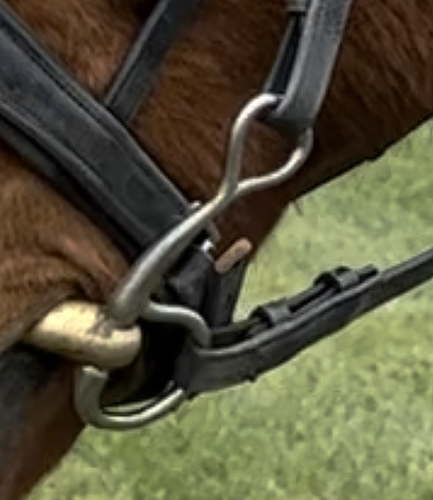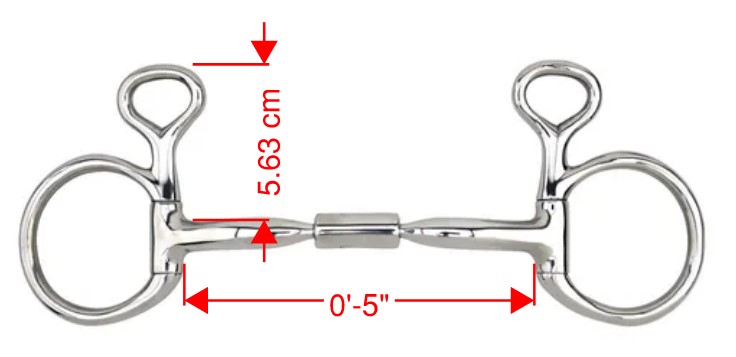Well that’s a bummer! It took me a long time to find a bit for my redhead, and I did the Ns quiz, and after some more conversations with them, they recommended the NS turtle top Baucher. Alas it has VERY long arms. I guess it’s back to the drawing board for us!
As many have mentioned before bauchers don’t have any leverage. Some others have drawn some really great diagrams and have explained it beautifully. I thought I might be able to describe it in different words that may add to the conversation and help some who might still be trying to understand.
In physics a basic leverage bit is a type of class 1 lever. A teeter totter is another perfect example of a class 1 lever. They have three parts. 1. The effort arm, 2. the fulcrum (the pivot point), and 3.the load arm.
Levers work by rotation. If they don’t have these three parts there is no rotation and therefore the lever doesn’t work. Just like a teeter totter with only one side really does nothing because it can no longer rotate around a pivot point. It’s just a board on a rock at that point, but there will be no rotation and thus no leverage.
A typical curb bit has these three parts.
- shank-a point below the mouthpiece that the reins attach to. This is the effort arm of the lever.
- mouthpiece-this is the fulcrum, or pivot point.
- purchase-this is the point above the mouthpiece the cheek pieces attach to. This is the load arm of the lever.
A baucher bit only has a purchase and mouthpiece. There is no shank because the rein attaches in line with the mouthpiece. Just like a teeter totter that is cut in half there will be no rotation, no pivoting, so there is no leverage.
USDF may have reasons for regulating the size of the purchase other than leverage concerns, but changing the height of the purchase on a baucher will do nothing to leverage. It could be 15 cm’s long and there would still be no leverage because there still wouldn’t be a shank or effort arm. I hope they consult with a science-minded person or explain their reasoning, because this rule change doesn’t make much sense at all.
For those interested…bauchers do act very similarly to a full cheek with keepers. There was a study some years ago that I can’t seem to find anymore that used radiographs to show how different snaffles sit in the mouth. They found that bauchers and full cheeks sit in the mouth at a slightly different angle because of the connection to the cheek pieces that caused there to be a little less tongue pressure. A D-ring, or any other snaffle, is not similar to bauchers or full cheeks with keepers because they don’t have a purchase.
I really like bauchers because of their stability in the mouth. My horses have always done well in them. I had a crazy near death experience while I was riding my very traffic safe horse in an eggbutt and she had a momentary lapse of sanity and spooked at a dog in someone’s house right in front of a truck that was coming up behind us. Like anyone else would have done I pulled on the rein pretty hard in an attempt to save our lives. It worked but the bit pulled through her mouth a little. I realize that is not classy riding, but I never again want to be in an emergency and have that happen. Bauchers and full cheeks with keepers help prevent that type of thing happening in emergency situations. It just gives me a little more piece of mind should something like that ever happen again.
delete due to duplication
Dr. Hilary Clayton had done many studies regarding bits including several with fluoroscopy so that may be what you are referencing.
Here are two from the mid 80s:
A fluoroscopic study of the position and action of the jointed snaffle bit in the horse’s mouth
A fluoroscopic study of the position and action of different bits in the horse’s mouth
USDF summary article of these earlier studies
Searching for “Hilary Clayton bit studies” will bring up various scientific and layperson articles.
[edited to fix reply attribution]
Well, i was thinking about a green horse actually. Full cheek and Dring…they both have a side bar that exerts pressure to the opposite side of the mouth if you pull a rein away from horse’s body. For a green horse, i do that a lot. I actually find them interchangeable for the newly backed horse.
I don’t have a dog in this fight, as I don’t use a Baucher on any of my horses right now, BUT, I’m learning a lot on this thread! There are some smart people on these forums. 
I asked the TD about this at the show I was at last weekend. She is not eliminating anybody just warning them and allowing them to continue to show with the Boucher. She said to her knowledge as a TD, there is not one Boucher that will pass the measurement requirements.
I am still just mind boggled over the “why.”
Especially after my misconceptions have been dispelled about long cheek pieces changing action.
It makes literally no sense. And the fact that they obviously didn’t measure a single existing baucher makes it even more mind boggling. I don’t even ride in one and I’m mad about it 
I don’t either, but I’m mad too. And I have a Myler one for sale (barely used) if anyone wants a now illegal bit. 
I think it all started someone didn’t like the longer upper arm NS one for some reason with that bit being put “under review”. But clearly a step was missed in making the 5cm determination.
If you watch the NS video on the Turtle mouthpieces, they do talk about how they had to reconfigure the positioning/rotation of it in relation to the ring so the mouthpiece can sit flat on the tongue when in neutral. I think this is why the baucher arm is more curved looking…so the upper ring can not be positioned too far forward on the face of the horse. The upper arm looks normal if you look at it actually on a horse (easy to find on Google).
It, like an example someone posted above, also has a relatively small snaffle ring, making the overall length appear much longer but of course it’s not.
based on the responses from USDF/USEF, I’m cautiously optimistic that they will amend this. It seems that they don’t actually want to fully ban the bit, but rather clarify the length of the arm and yet this was clearly done without anyone actually measuring a single baucher to see if it would fit the number they picked. But since this is under review, hopefully they will pick a more acceptable number…like 7cm. My main concern, in the mean time is how long will this take? And what can I do in the mean time?
I got them to commit that the Bomber ported barrel was within regulations, yet they never changed the rule book.
I have the email receipts for that, too, so I just continue to show in it.
They won’t do anything.
From what I’ve read in the rule books over many years, the rule writers at USEF//USDF are not great thinkers when it comes to clarity of writing.
I was volunteering at a show this past weekend, and for one afternoon I was tasked with equipment checks. I asked about the boucher, and the TD, who is a pretty high-level TD (and don’t get me wrong, she was very nice) basically what’s being said on the internet is not all correct (not sure exactly what she meant), but she didn’t give me direction on it. I just stated that I’m going to ignore the boucher length (and there were quite a few), and she shrugged and let me go. Makes me wonder if anyone really knows what to do about this.
interesting. It definitely seems like there is some confusion and many TDs are taking the approach defaulting to leniency during all this. But, it’s a bit of a gamble since you never know what approach the TD will take. And usually my default when i’m worried about about lack of clarity is to get written approval from USEF and take the email with me. But in this case, it is the email that is confirming what is being said on the internet, ha.
in the meantime, i’m wondering if anyone here has myler baucher and has measured its arm? From pictures (which of course can be completely deceiving), it looks like it could be one of the smaller arms out there
I’m making some significant assumptions here, I don’t own this bit, but it looks like probably still a no go as written.
For those competing at GAIGs and still using a Baucher, is the plan to just get the TD to verify it’s okay before your test instead of waiting to see if it gets flagged?
So I messaged a friend who is an FEI TD.
SH: There’s some discussion (and consternation) online regarding the new rule regarding the length of the arms of Baucher bits. It seems that there are few, if any, that fall within the 5cm restriction. Do you have any information about this?
TD: That is the new rule, yes. I didn’t write it, but the direction is to minimize the lever effect of that bit because no other permitted snaffle has that property
SH: If you think back to Jr. High science, however, there is no lever because there is no fulcrum. So it doesn’t make sense to me. But if that’s the rule, that’s the rule.
TD: You would need to speak with Dr Clayton about that. She is the one who does the bit research and advises
TL/DR: Baucher users at this time are out of luck for recognized showing.


